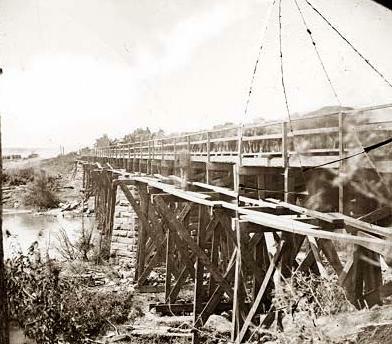 |
| Rappahanock River Bridge 1862 |
HEADQUARTERS THIRD CORPS,
Hampton, March 29, 1862-3 p. m.
Hampton, March 29, 1862-3 p. m.
Major-General McCLELLAN:
General Porter's division returned to camp at 6 p. m . Brigade went about 1 mile beyond the Half-way House, nearly 4 miles beyond Big Bethel. His skirmishers, some of Berdan's sharpshooters, went near to Howard's Branch, at Howell's Mill, where was seen a breastwork. Three deserters who came in yesterday morning from Yorktown report that General Magruder was there with nearly all his force, about 8,000 men, having left a guard of but 500 at Yorktown and in the batteries at Shipping Point. Our cavalry drove in their pickets, but captured none, their horses being too fleet. General Smith's division followed the road near James River from Newport News, encamped for the night at Watt's Creek, and returned to this camp yesterday morning. He reported a strong force at Young's Mill. From the best information I can obtain General Magruder has between 15,000 and 20,000 men under his command.
S. P. HEINTZELMAN,
Brigadier-General.
WARRENTON JUNCTION,
March 29, 1862-1 a. m.
General S. WILLIAMS, Seminary: Express just received from General Howard. He drove the enemy across the Rappahannock Bridge, and is now in camp on this bank of and near the Rappahannock River. The enemy blew up the bridge in his retreat. There was skirmishing during the march and a few shots exchanged by the artillery, without any loss on our side. Their loss, if any, is not known. General Howard will return to this camp to-morrow morning.
E. V. Sumner,
Brigadier-General, Commanding Second Army Corps.
Official Records, Series I., Vol. 11, Part 3, Page 47.
The Confederates were now faced with an advance on two fronts, Sumner and the 2nd Corp moving across Northern Virginia in the wake of Johnston's retreat towards Richmond and Heintzelman beginning the first tentative moves out of Fort Monroe and up the Peninsula towards Richmond. The frequency of firing and contact would soon increase as the two armies would find themselves increasingly in close proximity.
No comments:
Post a Comment